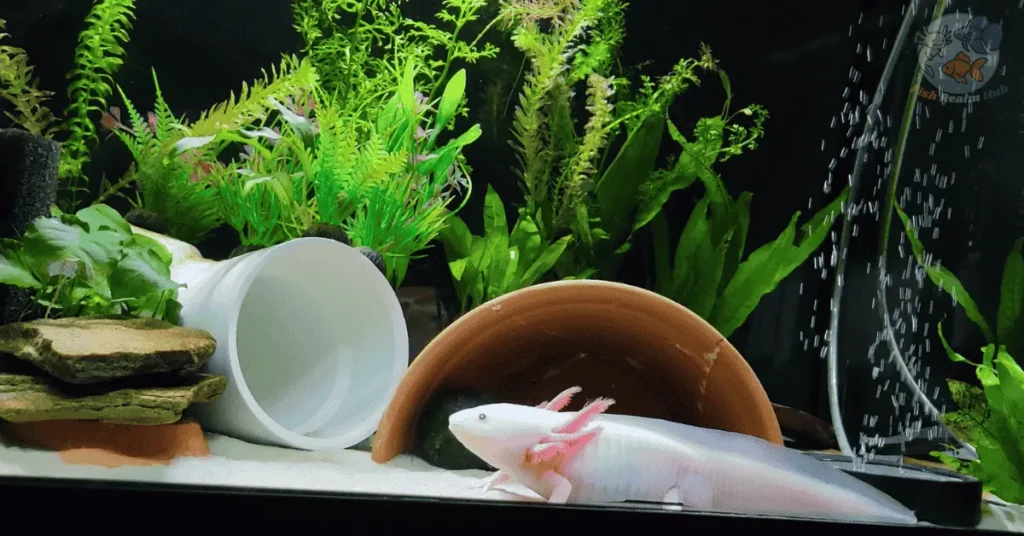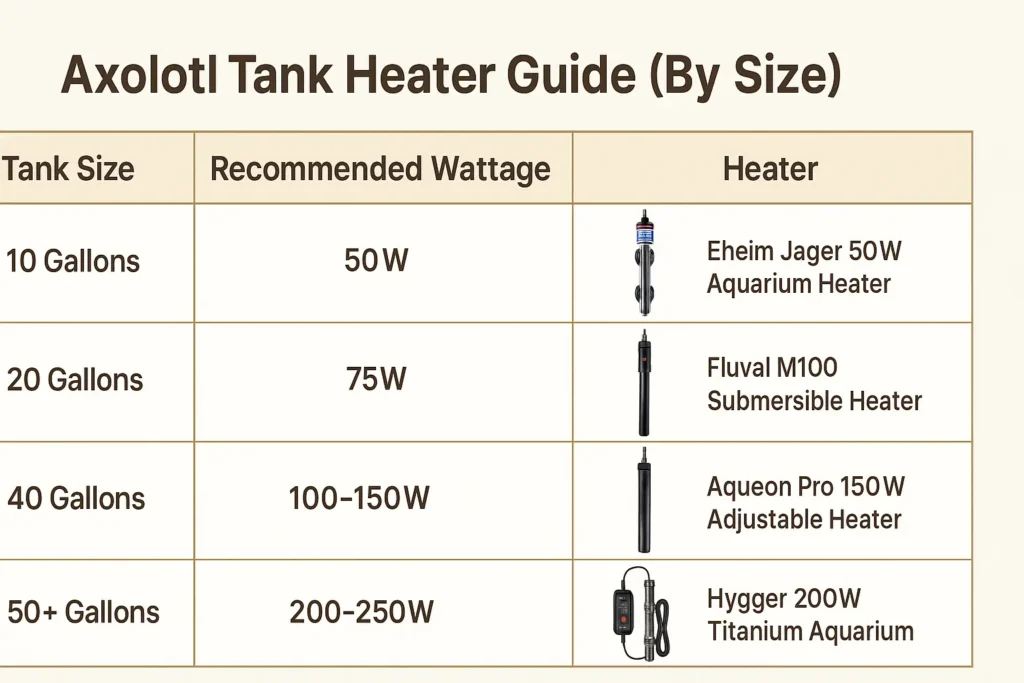When I first set up my axolotl tank, I wasn’t sure if I needed a heater or not. I kept checking the axolotl tank temperature every day because I read that axolotls don’t like sudden changes. During winter, the room got pretty cold, and I noticed my axolotl wasn’t moving around much.
That’s when I decided to try a low-watt aquarium heater with a built-in thermostat. It really helped keep the water stable and made a big difference in his behavior—he became more active again.

Later, I also learned a few tips on how to lower the temperature in an axolotl tank during hot days, just in case things got too warm.
Do Axolotls Need a Tank Heater?
When I first got into keeping axolotls, I didn’t know much about axolotl tank heaters or if they even needed one. I just knew that axolotls like cool water, so I thought a heater might do more harm than good. But then winter hit, and my room got really cold—like under 14°C (57°F).
I noticed my axolotl wasn’t swimming much, and he just stayed still at the bottom. That’s when I realized that even though axolotls like cold water, it still has to be within a safe range—usually around 16–18°C (60–65°F). If the water gets too cold, they can get stressed or sick.
So I looked into safe heaters for axolotl tanks and found a small adjustable heater with a thermostat. It helped keep the axolotl tank temperature stable without making the water too warm. I also learned that if your house stays cool enough, you might not need a heater at all.
But in colder areas, or during winter, a good aquarium heater for axolotls can actually help a lot. Just make sure it doesn’t overheat the tank, because too much warmth can be just as dangerous.
Ideal Water Temperature for Axolotls
The first time I noticed my axolotl acting lazy and not eating, I thought something was seriously wrong. I tested the water, and it turned out to be much colder than it should be. That’s when I learned how important the right axolotl tank temperature requirements are.
They prefer cool water, but not ice-cold—ideally around 16°C to 18°C (60°F to 64°F). Anything outside that range can really mess with their health.
Since then, I’ve been super careful about keeping the water steady. If the temperature jumps around too much, it stresses them out and can lead to sickness. A tank heater can help in colder months, but only if it has a thermostat.
Stable water isn’t just about comfort—it’s key to keeping your axolotl healthy and happy.
Can You Use a Heater in an Axolotl Tank?
I used to think axolotls never needed a heater, but last winter changed my mind. My room got really cold, and the water in the tank dropped too low. My axolotl became unusually still and wasn’t eating like it normally does.
That’s when I learned it’s actually okay to use a heater in an axolotl tank, especially in cold rooms or during winter. Just make sure it’s a safe heater with a thermostat, so it doesn’t overheat the water.
If the tank gets too warm, it can cause an axolotl temperature shock, which is really bad for them. So yeah, a heater can be helpful—but only if you use it carefully and keep an eye on the temperature.
Best Types of Heaters for Axolotl Tanks
I remember getting confused when I went to buy a heater with a thermostat for axolotl. There were so many options—submersible heaters, external heaters, adjustable ones, and even preset types.
After trying a couple, I found that submersible heaters with adjustable settings work best. They stay underwater and you can change the temperature easily, which helps keep the water just right for your axolotl.
If your tank is small, like 10 or 20 gallons, a 50-watt heater is usually enough. For bigger tanks, like 40 gallons or more, you’ll need a 100-watt or higher. The thermostat is super useful—it shuts off the heater once the water gets too hot.
That keeps things stable, which axolotls really need. I’ve also added some cool axolotl tank decor ideas to make the setup look nice while still keeping it functional and safe.
Axolotl Tank Heater Guide (By Size)

| Tank Size | Recommended Wattage | Heater Type | Heater Name |
| 10 Gallons | 50W | Submersible + Thermostat | Eheim Jager 50W Aquarium Heater |
| 20 Gallons | 75W | Submersible + Thermostat | Fluval M100 Submersible Heater |
| 40 Gallons | 100W–150W | Submersible + Thermostat | Aqueon Pro 150W Adjustable Heater |
| 50+ Gallons | 200W–250W | External + Thermostat | Hygger 200W Titanium Aquarium Heater |
All of these come with built-in thermostats so your axolotl’s water doesn’t get too warm.
How to Safely Install a Heater in Your Axolotl Tank
When I had to set up a heater in my axolotl tank, I was a bit nervous because I didn’t want to mess things up and hurt my axolotl.
There are a few steps to install a heater in your axolotl tank.
- Choose a heater that has a built-in thermostat to maintain a stable and safe water temperature for your axolotl.
- Place the heater close to the filter output so the warm water spreads evenly across the tank.
- Place a thermometer on the other end of the tank to keep an accurate check on the temperature.
- Use a heater guard to stop your axolotl from coming into direct contact with the heater and getting burned.
- Let the heater sit fully in water for 15–20 minutes before turning it on to avoid cracking or damage.
- Set the temperature between 16°C to 18°C (60°F–64°F), which is perfect for axolotl health.
- Monitor the temperature every day to ensure everything stays consistent and functions as it should.
Better Ways to Keep Your Axolotl Warm Without a Heater
When my room got cold during winter, I didn’t want to risk using a tank heater for my axolotl, so I tried some safer ways instead. First, I used a small room heater to keep the whole room warm, which helped the tank water stay at a steady temperature.
Then, I wrapped the tank with a thick towel and added styrofoam panels on the sides to hold in the heat—kind of like giving the tank a jacket. I also moved the tank away from my window and air vent because cold drafts were making the water drop too fast.
These small changes really helped keep my axolotl cozy without needing an actual heater.
How to Know If Your Axolotl Is Too Hot or Too Cold
One time, I noticed my axolotl was just lying still at the bottom and not eating, and that’s when I learned water temperature matters a lot. When it’s too cold, they get super slow and stop moving much. But if it’s too hot, they start acting stressed—like swimming around quickly, trying to escape, or their gills curl forward.
Hot water can even cause serious illnesses. Now I always keep a thermometer in the tank and try to keep the temperature between 60–64°F. I also moved the tank away from windows and vents so the temperature doesn’t change too fast. Just watching how they act helps you know if something’s wrong.
Conclusion
After everything I’ve learned from taking care of my axolotl, I can honestly say that managing the tank temperature is one of the most important parts of keeping them healthy. Whether you use a heater or rely on room temperature and insulation tricks, the goal is the same—keep the water steady between 60–64°F (16–18°C).
A sudden change, whether it’s too cold or too hot, can really stress your axolotl out or even make them sick. So whether you’re using a reliable heater with a thermostat or trying other smart methods like styrofoam wraps and room heating, just make sure you check the temperature every day and make small seasonal adjustments. Trust me, your axolotl will thank you with happy, active swimming!
FAQs
Do axolotls need a heater in their tank?
Axolotls are cold water aquatic animals, and from what I’ve seen with mine, they can get really stressed if the temperatures go above 70° Fahrenheit or 21° Celsius. I learned that when your aquarium is placed somewhere that gets too warm, you don’t always need a heater—sometimes the better method is to use a chiller or some kind of water-cooling setup to maintain cooler water. These tricks help keep their environment safe without risking overheating.
Is 72 degrees too hot for an axolotl?
In most situations, if you want to keep axolotls healthy in your home aquarium, it’s best to stay within the recommended temperature range of between 55-68F, with around 64F being the sweet spot. I once let my tank hit 72°F, and my axolotl started acting weird—less movement, less appetite. That’s when I realized going outside this safe range can stress them out, even if it’s just a few degrees over.
How cold should my Axolotl tank be?
One big difficulty I faced after learning the nitrogen cycle was getting the tank temperature right. Axolotls require COLD water—ideally close to 65°F, and it should always stay under 70°F. A tank heater for a typical tank might seem cheap, but it won’t cool the water. In most places, keeping the water cold at all times isn’t possible without an aquarium chiller, and the price of that equipment can be around 500.00 to 800.00.
What happens if axolotl water is too warm?
When the water in my axolotl tank got too warm once, I noticed signs of stress—like floating, loss of appetite, and even some light swelling. I later found out that excessively high temperatures, especially anything above 24°C or 75°F, can be really detrimental. It can lead to serious health problems, and if not addressed, it might even end up causing diseases or death in your axolotl.

